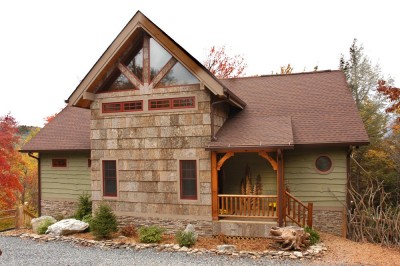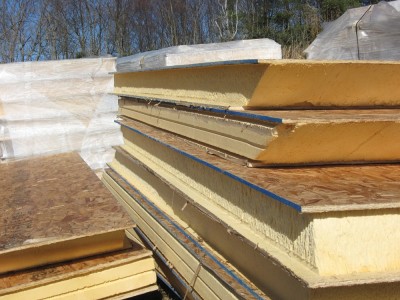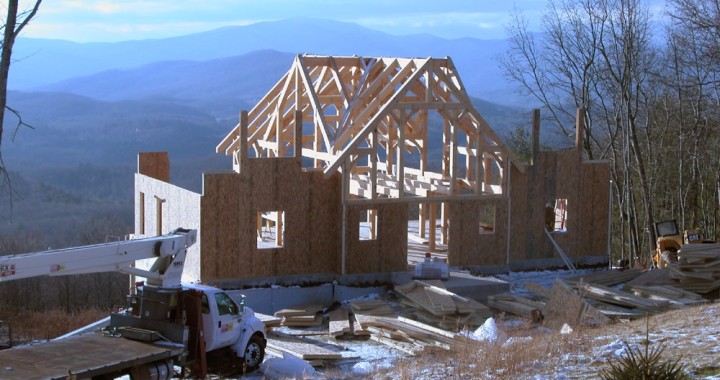
by Mark Kirkpatrick, President of Mountain Construction Enterprises
for a free consultation about your building needs CONTACT US
Structural Insulated Panels, also known as SIPs are an important part of Green Building Technology. They are a composite building material consisting of two layers of structural board with an insulating layer of foam in between.They are part of a high performance panelized building system. The board can be sheet metal or OSB board, an engineered wood product, and the foam is of some form of polystyrene. SIPs create an extremely well-insulated and air-tight building envelope. An efficient home building envelope is a critical component in an effectively integrated green building.
SIPs share the same structural properties as an I-beam or I-column. SIPs replace several components of conventional building such as studs and joists, some insulation, vapor barriers and air barriers. They can be used in place of or to augment many different building applications such as exterior wall, roof, floor and foundation systems.
The high R-Value and low levels of air infiltration capable with SIPs enables the performance of other building systems, such as energy efficient HVAC equipment and photovoltaic cells, to be maximized. These components will not be saving as much energy as they could if there are thermal bypasses in the building envelope.

spruce pine nc luxury homes
EFFICIENT RESOURCE USE
The OSB used in SIP skins is made from small, plantation grown trees that can be harvested in a sustainable manner. Because engineered wood products use wood more efficiently than sawn lumber, it requires less forest acreage to build a SIP home than a conventional wood framed house.
Expanded polystyrene (EPS), polyurethane, and polyisocyanurate foam cores used in SIPs are made of mostly air and very little petroleum. The average SIP home saves nineteen times the energy it took to make the EPS insulation in the first year of installation.
ENERGY EFFICIENCY
SIPs have a high R-Value foam core without any thermal bridging studs or areas of potential compression or voids in the insulation. SIP homes also have extremely low levels of air infiltration because there are fewer gaps to seal. When combined with other high efficiency systems, SIP homes commonly demonstrate 50%-70% savings over the Model Energy Code (MEC).
SIPs have been a key component in the creation of zero energy buildings, which produce more energy than they consume.
Read more on the energy saving benefits of SIPs.
REDUCED EMISSIONS
The Environmental Protection Agency (EPA) estimates that the average U.S. home releases 22,000 lbs of carbon dioxide (CO2) into the atmosphere each year. That is twice the amount of the average vehicle.
By reducing the amount of energy used for heating and cooling, SIPs can significantly cut the emissions produced by our homes and commercial buildings.
INDOOR AIR QUALITY
In recent years, a growing body of scientific evidence suggests that the air inside the places we live and work can be more polluted than the air outdoors. This poses a serious health risk to occupants. Poor indoor air quality can lead to sore eyes, throat, and nose, headaches, increased susceptibility to viruses, and asthma-like symptoms.
The degree of building tightness capable with SIPs enables better control over indoor environmental quality. SIP homes typically require mechanical ventilation. Mechanical ventilation allows all incoming air to be filtered for allergens. Air conditioning units can more effectively dehumidify indoor environments in a building with low levels of air infiltration. Both mold and dust mites cannot survive in low humidity environments.
The solid core insulation of SIPs is free of the voids, compressions, or thermal bypasses often associated with mold growth in wood frame, fiberglass insulated construction. Because SIP structures can be erected and dried in quicker than wood frame construction, there is less time for building materials are exposed to the elements and therefore less moisture that must be removed from the completed building. Structural insulated panels are inert and stable, and do not off gas chemicals.
WASTE MINIMIZATION
SIPs are primarily fabricated offsite, so there is extremely little jobsite waste disposal. Many manufacturers cut SIPs using optimization software that minimizes the amount of waste in the production process. Excess EPS waste created during the manufacturing process is recycled to make other EPS products. Jobsite waste can often be returned to the panel manufacturer for EPS recycling. Framing scrap accounts for a large portion of construction waste. Structural Insulated Panels offer a simple solution to construction waste reduction that is important to reducing the overall environmental impact of a commercial building or new home.
Mountain Construction Company are North Carolina Builders that specialize in New Home Construction. We also can provide Remodeling services, and are happy to work with you on your next Log Cabin. Over the years, we have built many Timber Frame Homes, and we invite you to take a look through our site to see some examples of our work.
You are welcome to reprint this articles on your website and in your e-newsletter provided that: you don't change the article in any way and you included the by-line along with a link to this website.


